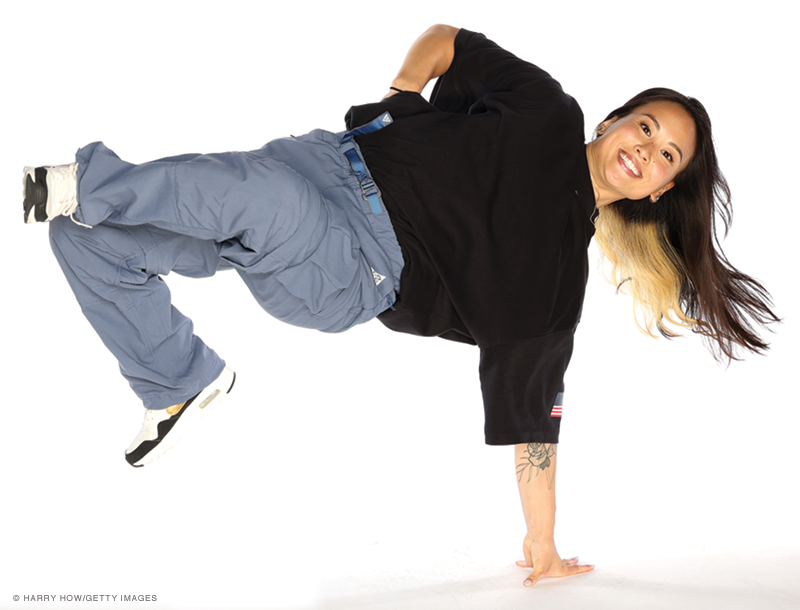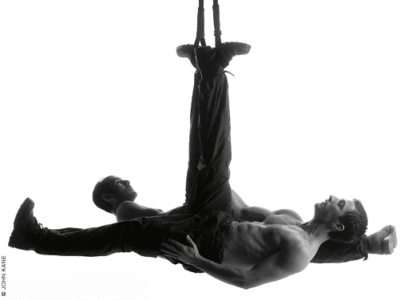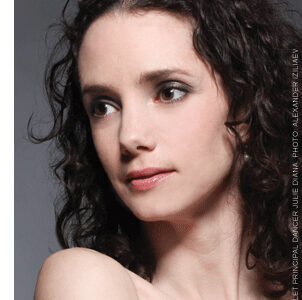
How a youth gymnast with a sunny disposition breakdanced her way into this summer’s Olympics.
Grace Choi W’11 bounds out onto the stage with a markedly different energy than her fellow breakdancers.
Her walk is not a practiced swagger or rehearsed stomp. The b-girl, as female breakdancers are called, has a spring in her step, flashing a smile and waving peace signs. Maybe it’s the fact that at age 35, she’s readying to battle competitors half her age, in a sport where some peak in their mid-teens. Or maybe it’s the bubbliness of her personality—hence her b-girl name “Sunny,” a play on her Korean birth name and her disposition.
“I do think I dance a little bit different from other people,” Choi says, “and I think it’s because I’m not trying to fit the mold of what a breaker should look like but just being me out there, and unapologetically so.”
Choi has followed a long road to that self-belief—and her journey just got a little longer. Her win at the Pan Am Games in Chile in November assured that she will represent the United States as one of the 16 b-girls competing at the 2024 Summer Olympics in Paris. It’s the first (and maybe only) time that breaking, better known when it developed on the streets of New York’s hip-hop scene as breakdancing, will be included in the Games.
A first-generation American from a Korean family who was raised in Kentucky, educated in the Ivy League, and has worked in corporate jobs in New York, Choi may not fit the stereotypical profile of a breakdancer. But the onetime aspiring gymnast has become the face of American breaking thanks to a chance encounter on Penn’s campus.
Choi’s parents left South Korea for the US, where her father received a doctorate in chemical engineering. Sunny was born in Tennessee and raised in Louisville—one of four children expected to be high achievers in whatever they did.
Gymnastics captured her imagination from a young age. Transfixed by the 1992 Olympics, she pestered her mother into bringing her to a local YMCA class. She hoped to join the gymnastics team at Penn, but a knee injury in high school requiring two surgeries closed that door.
With a void to fill and feeling adrift at Penn, Choi one day saw kids breakdancing on campus. When they introduced her to the monthly gathering of the Freaks of the Beat breaking club at the Rotunda, it all clicked. “I walked into the Rotunda, and I was like, Oh my god, this is incredible,” she recalls. “I was scared out of my mind. I couldn’t participate. I was just watching from the sidelines, but the energy was amazing. It was something very new to me.”
In breaking, Choi found something she realized had been missing from gymnastics: a creative outlet to be herself. Whereas gymnasts follow a rehearsed routine as precisely as possible, breaking is a more free-flowing form of expression. Battles entail a call and response, whether playing off members of a crew or dancing in 1-v-1 battles (which will be the Olympic format). The music, generated on the spot by a DJ, requires dancers to be in the moment, to improvise and to flow. Choi found the challenge intoxicating.
But she didn’t see a future in it. When she graduated from Penn with a degree in marketing, she made her way in 2012 to New York to work a series of corporate jobs, the most recent as director of global creative operations for Estée Lauder’s skincare division.
“I thought it was just going to be a hobby, honestly,” she says, figuring she would “work a corporate job just like everybody else, make a paycheck and a relatively stable living off that, and breaking would be my outlet and I would keep it as a pastime or a hobby. That’s not really what happened, though.”
She’d become a star in that hobby—and a world traveler, too. Choi first competed internationally in 2014 and her first big trophy came at Outbreak Europe in 2015 in Slovakia, an event only one American had won in the event’s first five years. She finished second at both the World Urban Games in Hungary and her first World Dance Sport Federation World Championships, in Nanjing, China.
As Choi’s profile grew, so did the sport. Breaking debuted successfully at the 2018 Youth Olympics in Buenos Aires. In 2019, the Paris Olympic Organizing Committee floated the idea of adding it to the 2024 Games, and the International Olympic Committee assented in 2020. (The Los Angeles Olympics did not put forth breaking as a candidate for 2028.)
Meanwhile, Choi finished seventh at the World Championships in 2021 and made the final of the 2022 World Games, an Olympic-style tournament for lesser-known sports.
The parallel growth trajectories of Choi and her sport eventually converged in a momentous decision. To pursue breaking full-time, she knew she’d need to go all in, with a trainer, nutritionist, and mental skills coach. Realizing how much of her life had been defined by “doing the thing that seems most responsible but not truly going after what I wanted,” she zeroed in on an Olympic spot.
In the fall of 2022 Choi made the leap. It required an apprehensive conversation with her parents, explaining why she was giving up what they regarded as her dream career. “When I first told them, my mom said, ‘I know you’ll succeed in whatever you do, so I support you,’” Choi says. “That was really, really reassuring. Because I was scared.” She sealed the deal that year by winning the Red Bull Cypher in Los Angeles with her mom in attendance. (As a token of that acceptance, Choi’s mom volunteered her to coach kids in breaking at their church back home.)
“It’s such a brave thing to do, and she had just complete support,” says her brother Joon Choi W’04. “I know that she really clearly had a dream and a vision, and I knew that she was going to be very intentional on what needed to be done to achieve that dream.”
Choi’s on-stage aura stands apart from her peers. She leans more
on creativity than power moves. While some (especially younger) dancers wow
solely with their array of spins, flips, and tricks, Choi’s footwork shines
with a gymnast’s precision, and her transitions between moves lend the whole
performance a cohesive, almost narrative quality. “There’s a precise,
analytical piece that shows in my breaking,” she says, “which I feel like you
see in most gymnastics but not something you always see
in breakers.”
It comes back to Choi knowing who she is when the music starts, a journey in its own right. Choi’s signature smile was many times a put-on; she’s battled imposter syndrome along the way—at Wharton, in corporate America, and on the dance floor. Now, it’s an authentic manifestation of joy—a recognition of having found her place in the world via breaking.
“I think the biggest thing I want people to take away is just being OK with being you,” she says. “So much of my breaking story has been about accepting who I am and being able to be me on the stage, despite being told over and over and over again that I smile way too much on stage, because that’s not what breakers do. But this is who I am, and this is a form of self-expression, and this is what I need to do.”
—Matthew De George




